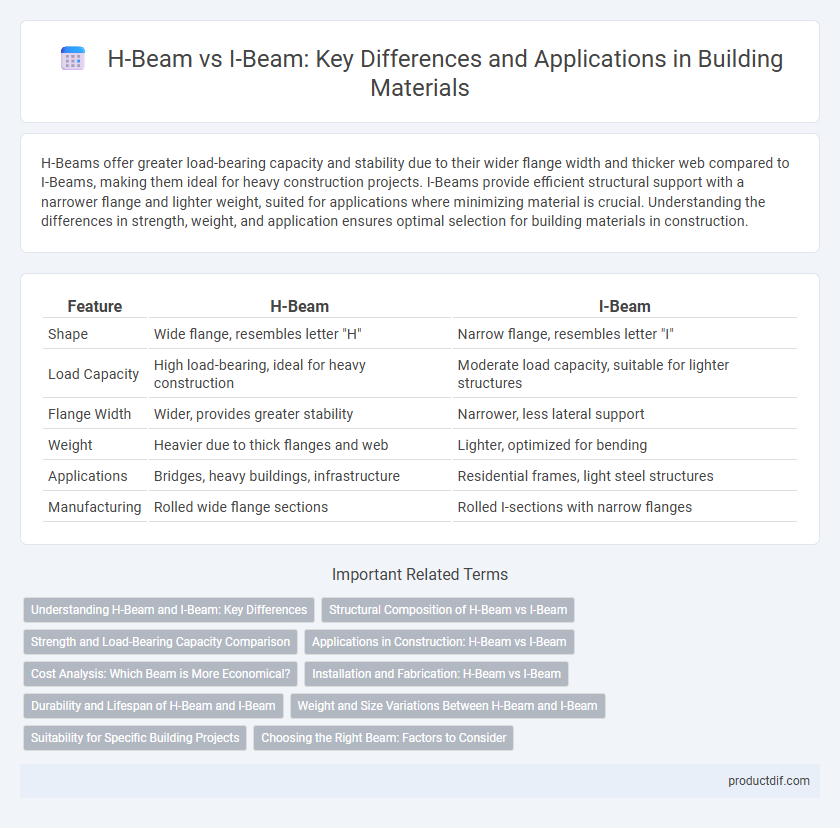H-Beams offer greater load-bearing capacity and stability due to their wider flange width and thicker web compared to I-Beams, making them ideal for heavy construction projects. I-Beams provide efficient structural support with a narrower flange and lighter weight, suited for applications where minimizing material is crucial. Understanding the differences in strength, weight, and application ensures optimal selection for building materials in construction.
Table of Comparison
| Feature | H-Beam | I-Beam |
|---|---|---|
| Shape | Wide flange, resembles letter "H" | Narrow flange, resembles letter "I" |
| Load Capacity | High load-bearing, ideal for heavy construction | Moderate load capacity, suitable for lighter structures |
| Flange Width | Wider, provides greater stability | Narrower, less lateral support |
| Weight | Heavier due to thick flanges and web | Lighter, optimized for bending |
| Applications | Bridges, heavy buildings, infrastructure | Residential frames, light steel structures |
| Manufacturing | Rolled wide flange sections | Rolled I-sections with narrow flanges |
Understanding H-Beam and I-Beam: Key Differences
H-Beams and I-Beams differ primarily in their flange width and load-bearing capacity, with H-Beams featuring wider flanges that provide greater stability and strength for heavy load applications. I-Beams have narrower flanges and are typically used in lighter construction projects where resistance to bending is essential. The choice between H-Beam and I-Beam impacts structural integrity, cost efficiency, and suitability for specific building material requirements.
Structural Composition of H-Beam vs I-Beam
H-Beams feature wider flanges and thicker webs compared to I-Beams, enhancing their load-bearing capacity and resistance to bending. The structural composition of H-Beams allows for greater stability in support applications due to their more box-like cross-section. In contrast, I-Beams have narrower flanges and thinner webs, making them lighter but less effective at handling lateral loads.
Strength and Load-Bearing Capacity Comparison
H-Beams typically offer greater load-bearing capacity and structural strength compared to I-Beams due to their wider flange and thicker web, which distributes weight more efficiently. The increased surface area of H-Beams enhances resistance to bending and shear forces, making them ideal for heavy construction applications. I-Beams, with narrower flanges, provide adequate strength for lighter loads but are less effective under high stress or lateral loads compared to H-Beams.
Applications in Construction: H-Beam vs I-Beam
H-Beams provide superior load-bearing capacity and are ideal for heavy construction projects such as bridges, high-rise buildings, and industrial structures due to their wider flange and thicker web. I-Beams are commonly used in residential and light construction because their narrower flange offers ease of installation and is effective for supporting lighter loads. Selecting between H-Beam and I-Beam depends on structural requirements, with H-Beams suited for high load and stability, while I-Beams offer cost efficiency and versatility in smaller scale applications.
Cost Analysis: Which Beam is More Economical?
H-beams generally offer better cost efficiency due to their wider flange and greater load-bearing capacity, reducing the need for additional support structures. I-beams, while typically less expensive per unit, may require more material and labor in applications needing higher strength, increasing overall project costs. Evaluating project-specific load requirements and fabrication expenses is essential to determine which beam provides the most economical solution.
Installation and Fabrication: H-Beam vs I-Beam
H-Beams feature wider flanges and thicker sections that simplify fabrication by allowing easier welding and bolting, making them ideal for heavy load-bearing applications. I-Beams, with narrower flanges and thinner web, require more precise alignment and additional reinforcement during installation to maintain structural integrity. The choice between H-Beam and I-Beam impacts installation speed and labor costs due to differences in weight, handling, and connection methods.
Durability and Lifespan of H-Beam and I-Beam
H-Beams offer greater durability due to their thicker flanges and wider web, which provide enhanced resistance to bending and shear forces compared to I-Beams. The robust design of H-Beams contributes to a longer lifespan in structural applications, especially in heavy load-bearing scenarios. I-Beams, with their narrower flanges, may experience faster wear and require more maintenance, making H-Beams a preferable choice for projects demanding extended durability.
Weight and Size Variations Between H-Beam and I-Beam
H-Beams typically have wider flanges and thicker web sections compared to I-Beams, resulting in a heavier weight for the same length. The size variations include H-Beams being bulkier and providing greater load-bearing capacity, while I-Beams are slimmer and lighter, making them suitable for applications where reduced weight is critical. Weight differences affect transportation and installation costs, with H-Beams offering enhanced structural strength but increased mass.
Suitability for Specific Building Projects
H-Beams offer greater load-bearing capacity and are ideal for heavy construction projects like bridges and skyscrapers due to their wider flange and thicker web. I-Beams provide excellent bending resistance and are better suited for lighter structures such as residential buildings and small commercial projects. Selecting the appropriate beam depends on structural load requirements and project scale for optimal stability and safety.
Choosing the Right Beam: Factors to Consider
Selecting the right beam involves evaluating load capacity, span length, and structural requirements, with H-beams offering higher load-bearing capacity and better resistance to bending due to their wider flange compared to I-beams. I-beams are typically lighter and more cost-effective for shorter spans and moderate loads, making them suitable for residential and smaller commercial projects. Consider factors such as installation ease, material cost, and project specifications to determine whether H-beam or I-beam aligns best with the structural demands.
H-Beam vs I-Beam Infographic

 productdif.com
productdif.com